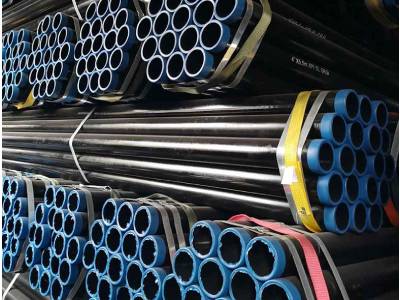Welded Steel Pipes, also called seam steel pipes, are generally formed by coil welding of steel plates or steel strips. According to the surface treatment form of the pipe, there are two types: galvanized and non-galvanized. The galvanized white surface is also called white iron pipe or galvanized steel pipe. Common welded steel pipes without galvanized surface are also called black iron pipes.
Galvanized welded steel pipes are often used for pipelines that require relatively clean transport media, such as domestic water, purified air, instrument air, etc.; non-galvanized welded steel pipes can be used to transport steam, gas, compressed air, and condensate.
According to user requirements, welded steel pipes can be divided into two types at the factory: one is the pipe end with thread, the other is the pipe end without thread. For welded steel pipes with threaded ends, the length of each pipe is 4-9m, and for welded steel pipes without threads, the length of each pipe is 4-12m.
Welded steel pipes are divided into thin-walled steel pipes, thickened steel pipes and ordinary steel pipes according to the thickness of the pipe wall. The most used process pipeline is ordinary steel pipe, and its test pressure is 2.0MPa. The test pressure of the thickened steel pipe is 3.0MPa.
There are many connection methods for welded steel pipes, including threaded connection, flange connection and welding. The flange connection is divided into threaded flange connection and welding flange connection, and the welding method is divided into gas welding and arc welding.

Carbon Steel Seamless Pipe
Seamless Steel Pipes are the pipes with the largest consumption and most specifications in industrial pipelines.
Basically divided into:Seamless steel pipes for fluid transportation and seamless steel pipes with special purpose. The former are commonly used steel pipes for process pipelines, and the latter are steel pipes for boilers, cracking furnace pipes and heat exchangers.
According to the material, it can be divided into:Carbon seamless steel pipe, chromium molybdenum seamless steel pipe and stainless, acid-resistant seamless steel pipe.
According to the nominal pressure, it can be divided into:Low pressure (0≤1.0MPa), medium pressure (1.0<10MPa=, high pressure (≥10MPa) three types.
The commonly used materials for Carbon Steel Seamless Pipe are No. 10, No. 20 and 16Mn steel. Its specification range is: hot rolled outer diameter φ32~630mm, cold drawn outer diameter φ6~200mm, single tube length 4~12m, allowable operating temperature is -40~450℃. It is widely used to transport various non-corrosive media to steel, such as transporting steam, oxygen, compressed air, oil and oil and gas.
Low alloy steel seamless steel pipe refers to alloy steel pipe containing a certain proportion of alloying elements. Usually divided into two types: one is low-alloy steel pipe containing manganese, called ordinary low-alloy steel pipe, such as 16Mn, 15MnV, etc.; the other is low-alloy steel pipe containing chromium, molybdenum and other elements, called chromium-molybdenum steel pipe. Commonly used are 12CrMo, 15CrMo, 12Cr2Mo, 1Cr5Mo, etc. The specifications range from outer diameter φ10~φ273mm, single pipe length 4~12m, applicable temperature range of chromium molybdenum steel pipe is -40~550℃. Low-alloy seamless steel pipes are mostly used to transport all kinds of higher temperature oils, oil and gas, less corrosive salt water, and low-concentration organic acids.
According to the different content of various metals such as chromium, nickel and titanium, stainless and acid-resistant seamless steel pipes have many varieties, including Cr13, 00Cr17Ni14Mo2, 1Cr18Ni12Mo2Ti, 1Cr18Ni9Ti, etc. Among these steel grades, the most used is 1Cr18Ni9Ti, which is often represented by simplified material code 18-8 on construction drawings, and the applicable temperature range is -196~700℃. In chemical production, it is used to transport various corrosive media, such as nitric acid, acetic acid and urea.
The material of the high-pressure seamless steel pipe is basically the same as the above-mentioned seamless steel pipe, except that the pipe wall is thicker than the medium and low-pressure seamless steel pipe, and the thickest pipe wall is up to 40mm. For example, the specifications of high-pressure seamless steel pipes for fertilizer equipment are φ14×4(mm)~273×40(mm), the length of a single pipe is 4~12m, the applicable pressure range is 10~32MPa, and the working temperature is -40~400℃. In petrochemical plants, the above high-pressure seamless steel pipes are used to transport media such as raw material gas, hydrogen nitrogen, synthesis gas, water vapor, high-pressure condensed water and so on.
Low-temperature steel pipes are used in the cold zone of imported engineering projects. The material grades are STPL-39 and STPL-46, and the working temperature can reach -105℃. Low-temperature steel pipes are divided into seamless steel pipes and seamed steel pipes. The nominal diameter of seamless low-temperature steel pipes is 15~400mm, and the wall thickness is the same as that of carbon steel pipes; the nominal diameter of seamed low-temperature steel pipes is 400~1100mm and the wall thickness is 6~10mm. The standard length of the root canal is 6m. It is suitable for conveying various non-corrosive low-temperature media pipelines. At present, there is no mass production of steel pipes corresponding to this standard in China.
Previous: Activated Carbon is Used in Electroplating Purification
Next: Waste Activated Carbon Needs Timely And Effective Recovery
Copyright:@2020-2021
Comments Please sign in or sign up to post.
0
0 of 500 characters used